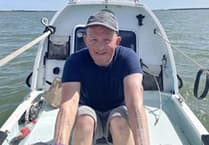Dolgellau’s Elfyn Evans says Rally Estonia brings a complete change of territory and with it a change of mentality.
After a trio of rough and increasingly demanding gravel rallies in Portugal, Sardinia and Kenya, attention now turns to smoother and quicker roads with Rally Estonia followed two weeks later by Rally Finland: the fastest round of the World Rally Championship.
Toyota Gazoo Racing has a strong record in Estonia together with its reigning drivers’ champion, Kalle Rovanperä, who scored his maiden WRC victory on the event in 2021 before repeating that success last year.
Rovanperä leads the 2023 standings by 41 points over Elfyn Evans, who completed a one-two finish for the team in Estonia last year.
Both were part of a second successive 1-2-3-4 finish for TGR-WRT on Safari Rally Kenya last month, along with Sébastien Ogier and Takamoto Katsuta.
With Estonia not included in Ogier’s part-season programme, Katsuta steps up once more to help the team defend a 48-point lead in the manufacturers’ championship.
Evans said: “Estonia brings a complete change of territory and with it a change of mentality.
“We’re coming off the back of some rough and relatively low-speed rallies and moving onto extremely high-speed and smooth gravel, and these next events are all about confidence and commitment behind the wheel.
“As a driver, you need to have trust in your pacenotes and also have a good feeling with the car, so we were working hard during our pre-event test last week to try and get everything right.
“Hopefully we can go into it feeling good from the beginning and really enjoy the driving, which is really key to performing well on a rally like this one.”
TGR-WRT continues to work to develop the GR YARIS Rally1 HYBRID and improve performance, and will introduce a power unit upgrade in Estonia that includes an updated internal combustion engine.
While many of the roads used in Rally Estonia are wide and flowing, featuring plenty of jumps and crests, others are narrower and more technical.
In these sections in particular, the soft and sandy surface can become heavily rutted by the second pass of each stage.
As has been the case since the rally first joined the WRC calendar in 2020, the service park will be situated at the Estonian National Museum in the country’s second-largest city, Tartu – around two hours south-east of the capital, Tallinn.
The popular ceremonial start in the centre of Tartu on Thursday evening is followed by an opening super special stage adjacent to the service park.
Friday is the longest day of the rally with 133.38 competitive kilometres: the familiar Peipsiääre and Mustvee stages to the north and Raanitsa to the south are all run twice either side of mid-day service, before a single pass of Neeruti rounds out the day.
Saturday’s format is different, with two stages run twice in the morning before service, and another pair of tests repeated in the afternoon.
The Tartu super special is revisited upon returning to service in the evening.
Sunday’s finale is made up of two runs over the mostly-new Karaski stage and an extended version of Kambja, which again hosts the rally-ending Power Stage.




